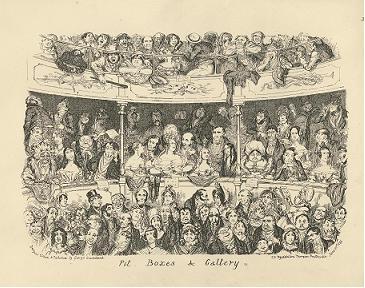Categorizing theatre and music-hall audiences by class is typically Victorian and throughout the period changed as the city grew in population and dropped in the country.
 The division of auditoriums into boxes, pit and gallery continued into the 19th century. To attract the upper class patrons, separate entrances were created for each of the sections so that box holders would not have to make contact with the lower class customers.
The division of auditoriums into boxes, pit and gallery continued into the 19th century. To attract the upper class patrons, separate entrances were created for each of the sections so that box holders would not have to make contact with the lower class customers.
As the population of London increased, the census concluded that 79% of the population was working class and that putting all classes under one roof in two or three central playhouses was no longer possible. The construction of neighborhood theatres increased throughout the city.
With the construction of the docks on the East End, the population consisting of mostly working class people began to grow along with the establishment of its own entertainment network not unvisited and unrecognized by the rest of London.
The Grecian and Britannia in Hoxton and the Effingham in Whitechapel opened as saloon theatres between 1834 and 1843. These and others continued to be built and rebuilt until the late 1860s when one by one they began to close.
A report from the Select Committee on Theatrical Licenses and Regulations reported that the capacity of six East End theatres amounted to 17,600 or 34.3 percent of the total audience capacity of London theatres excluding Covent Garden and Her Majesty's which were opera houses. The capacities not indicated were of music halls, penny gaffs in the East End as well as the large saloon theatres.
To attract new clientele, theatre owners began dropping their prices in lieu of profit from a few to profiting from volume and while East Enders traveled to the West to attend galleries of middle-class theatres, the East End theatres were not successful in attracting clientele from outside their immediate neighborhoods. At the same time, wealth among the middle class began to grow and attendance at the theatres increased.
The more popular theatres, Drury Lane, Covent Garden and Haymarket were not overwhelmed by working class attendance as most could not afford to sit anywhere except in the gallery, but the increased wealth and shortening of work hours did permit more to attend.
Still it is risky to generalize on the composition of the 19th century audience based upon where they sat as attendance was also affected by the topic of the play as well and attendance varied from one theatre district to the other. The Victorians lived in their own culture and in their own network of economic an social relationships. Theatre was only a small part; and to fully understand its growth and popularity means knowing about social and cultural habits, jobs, wages, cost of living, places of residence, class status, means of transportation, patterns of migration and the political outlook.
The growth of theatre changed dramatically from 1837 to the present and each decade had its own effect upon its development. Despite its fight against the music hall, it also fought for its share of other events by opening its doors to lectures, panoramas, dioramas, magicians, minstrel shows, mesmerists, magic lantern presentations, circuses, and menageries. That the theatre became so successful in appealing to all classes of society while remaining profitable was no small feat.
Back to Intro/Index or Site Map
| | Family Gallery | Servants Parlour | Tour Home | Typical Day | Etiquette | Shopping Trip | |
| | Victorian Christmas | Victorian England Fun and Games | Ashton Library | Victorian Wedding | |
| | Victorian England Overview | Guest Registry | Honorary Victorian | Tours | |
| | Awards Received | Bibliography | |
| | 1876 Victorian England Home | |
Credits below copyright information |
| Contact
webmaster |
| Copyright
1999-2017 All Rights Reserved - B. Malheiro May not be reproduced in any way without express written permission of webmaster. |
Credits:
Background and buttons are the creation of webmaster, B. Malheiro. These images have been watermarked and are not for use on another site. Site authored by webmaster.